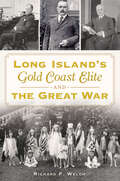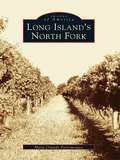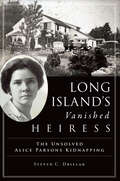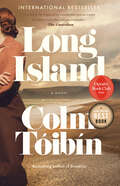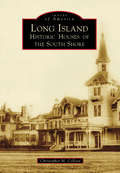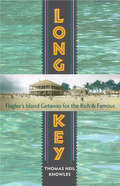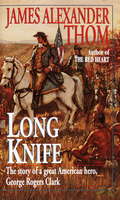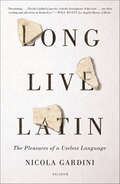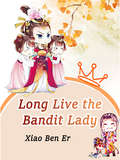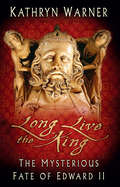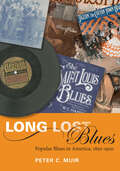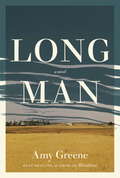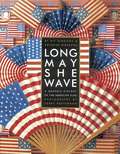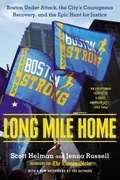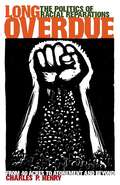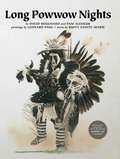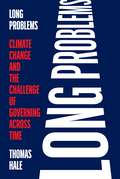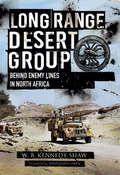- Table View
- List View
Long Island's Gold Coast Elite & the Great War
by Richard F WelchAt the outbreak of World War I, the Gold Coast of Long Island was home to the most concentrated combination of financial, political and social clout in the country. Bankers, movie producers, society glitterati, government officials and an ex-president mobilized to arrange massive loans, send supplies and advocate for the Allied cause. The efforts undercut the Wilson administration's official policy of neutrality and set the country on a course to war with Germany. Members of the activist families--including Morgans, Davisons, Phippses, Martins, Hitchcocks, Stimsons and Roosevelts--served in key positions or fought at the front. Historian Richard F. Welch reveals how a potent combination of ethno-sociological solidarity, clear-eyed geopolitical calculation and financial self-interest inspired the North Shore elite to pressure the nation into war.
Long Island's North Fork (Images of America)
by Maria Orlando PietromonacoBoasting a verdant landscape and miles of silky white beaches, Long Island's North Fork remains a natural paradise. Escaping the urbanization that overspread much of Long Island in the early 1900s, the rural villages survived on farming, fishing, shipbuilding, and maritime trading. Loyal residents have preserved the North Fork's rich heritage and tranquil pace of life. Thus, agriculture still thrives and boats continue to cruise the crystal-clear waters.Long Island's North Fork explores the past through the eyes of those who lived in the rustic countryside. It is a treasury of photographs, many taken by professionals, others from selected family albums and collections.
Long Island's Vanished Heiress: The Unsolved Alice Parsons Kidnapping (True Crime)
by Steven C. DrielakA new look at the 1937 abduction of a wealthy wife and mother, based on previously classified FBI documents—includes photos. When she was kidnapped from Long Meadow Farm in Stony Brook, New York, in 1937, Alice McDonell Parsons was the heir to a vast fortune among Long Island&’s wealthy elite. The crime shocked the nation and was front-page news for several months. J. Edgar Hoover personally assigned his best FBI agents to the case, and within a short time, Parsons&’s husband and their live-in housekeeper, Anna Kupryanova, had become prime suspects. Botched ransom attempts, clashes between authorities, and romantic intrigue kept the investigation mired in drama. The crime remained unsolved. Now, in this book, former Suffolk County detective Steven C. Drielak reveals previously classified FBI documents—and pieces together the mystery of the Alice Parsons kidnapping.
Long Island: A Novel
by Colm ToibinOPRAH&’S BOOK CLUB PICK * Named a Most Anticipated Book by The Globe and Mail, The New York Times, The Washington Post, The Financial Times, Good Housekeeping, and more.From the beloved, critically acclaimed New York Times bestselling author comes a spectacularly moving and intense novel of secrecy, misunderstanding, and love, the story of Eilis Lacey, the complex and enigmatic heroine of Brooklyn, Tóibín&’s most popular work twenty years later.Eilis Lacey is Irish, married to Tony Fiorello, a plumber and one of four Italian American brothers, all of whom live in neighboring houses on a cul-de-sac in Lindenhurst, Long Island, with their wives and children and Tony&’s parents, a huge extended family that lives and works, eats and plays together. It is the spring of 1976 and Eilis, now in her forties with two teenage children, has no one to rely on in this still-new country. Though her ties to Ireland remain stronger than those that hold her to her new land and home, she has not returned in decades. One day, when Tony is at his job and Eilis is in her home office doing her accounting, an Irishman comes to the door asking for her by name. He tells her that his wife is pregnant with Tony&’s child and that when the baby is born, he will not raise it but instead deposit it on Eilis&’s doorstep. It is what Eilis does—and what she refuses to do—in response to this stunning news that makes Tóibín&’s novel so riveting.Long Island is about longings unfulfilled, even unrecognized. The silences in Eilis&’ life are thunderous and dangerous, and there&’s no one more deft than Tóibín at giving them language. This is a gorgeous story of a woman alone in a marriage and the deepest bonds she rekindles on her return to the place and people she left behind, to ways of living and loving she thought she&’d lost.
Long Island: Historic Houses of the South Shore (Images of America)
by Christopher M. ColloraIn contrast to and predating Long Island's famous Gold Coast (the North Shore), communities along the Great South Bay were home to hundreds of less publicized, yet equally impressive, mansions and historic houses. These homes were once owned by prominent captains of industry, popular entertainment figures, and movers and shakers of the day, such as the Bourne, Cutting, Gardiner, Gulden, Gustivino, Guggenheim, Hollins, and Vanderbilt families. Long Island: Historic Houses of the South Shore explores the South Shore's famous resident personalities, including Schuyler Parsons, Fred Astaire, Anita Stewart, and Robert Pinkerton. The lifestyle of the South Shore is also portrayed, including activities like hunting and fishing as well as the famous beaches that served as tourist attractions.
Long Key: Flaglers Island Getaway for the Rich and Famous
by Thomas Neil KnowlesWith a modest two-story hotel and various small cottages, Long Key Fishing Camp offered a dramatic departure from the usual opulence of Henry Flagler’s hotels that dotted the east coast of Florida. The final resort opened during his lifetime, Long Key lacked palatial structures with manicured grounds, extravagant recreational facilities, and world-class amenities. Prospective visitors were frankly warned not to expect the same level of comfort provided at sister properties. Yet still they came.Carefully researched and replete with photographs and maps never before published, Long Key offers the first history of this unique destination. Historian Thomas Knowles recounts the extraordinary tale of how a railroad work camp became a world-renowned sportfishing center and a preferred vacation spot of a cadre of well-to-do individuals that included businessmen, poets, nobles, and politicians.This rustic island, with its unparalleled fishing grounds and cabins named after local fish—“The Kingfish,” “The Porpoise,” “The Barracoota,” “The Shark”—inspired fierce loyalty among its clientele, even during the dark years of the Great Depression. Zane Grey, Lou Gehrig, Wallace Stevens, Charles Kettering, Andrew Mellon, and Herbert Hoover were among those who would return season after season.Completely destroyed by the fatal 1935 Labor Day Hurricane, the first category 5 storm to make landfall in the United States, Flagler’s unique island getaway has been largely forgotten. Knowles expertly depicts this slice of long-lost Florida and resurrects the famous personalities who found refuge from the limelight at Long Key.
Long Knife: A Novel
by James Alexander ThomTwo centuries ago, with the support of the young Revolutionary government, George Robers Clark led a small but fierce army west from Virigina to conquer all the territory between the Ohio and Mississippi Rivers. Here is the adventure, the romance, the struggle, and the betrayal of his life. Rich in the heroic characters, meticulously researched detail and grand scale that have become James Alexander Thom's trademarks, LONG KNIFE, his first historical epic, is simply unforgettable.From the Paperback edition.
Long Live Latin: The Pleasures of a Useless Language
by Nicola GardiniA “fascinating” meditation on the joys of a not-so-dead language (Los Angeles Review of Books).From acclaimed novelist and Oxford professor Nicola Gardini, this is a personal and passionate look at the Latin language: its history, its authors, its essential role in education, and its enduring impact on modern life—whether we call it “dead” or not.What use is Latin? It’s a question we’re often asked by those who see the language of Cicero as no more than a cumbersome heap of ruins, something to remove from the curriculum. In this sustained meditation, Gardini gives us his sincere and brilliant reply: Latin is, quite simply, the means of expression that made us—and continues to make us—who we are. In Latin, the rigorous and inventive thinker Lucretius examined the nature of our world; the poet Propertius told of love and emotion in a dizzying variety of registers; Caesar affirmed man’s capacity to shape reality through reason; Virgil composed the Aeneid, without which we’d see all of Western history in a different light.In Long Live Latin, Gardini shares his deep love for the language—enriched by his tireless intellectual curiosity—and warmly encourages us to engage with a civilization that has never ceased to exist, because it’s here with us now, whether we know it or not. Thanks to his careful guidance, even without a single lick of Latin grammar, readers can discover how this language is still capable of restoring our sense of identity, with a power that only useless things can miraculously express.“Gardini gives another reason for studying classical languages: ‘The story of our lives is just a fraction of all history . . . life began long before we were born.’ This is the very opposite of a practical argument—it is a meditative, even self-effacing one. To learn a language because it was spoken by some brilliant people 2,000 years ago is to celebrate the world; not a way to optimize yourself, but to get over yourself.” —The Economist“Nicola Gardini’s paean to Latin belongs on the shelf alongside Nabokov’s Lectures on Literature. With a similar blend of erudition, reverence, and impeccable close reading, he connects the dots between etymology and poetry, between syntax and society. And he proves, in the process, that a mysterious and magnificent language, born in ancient Rome, is still relevant to each and every one of us.” —Jhumpa Lahiri, Pulitzer Prize winner and New York Times–bestselling author of Roman Stories
Long Live the Bandit Lady: Volume 1 (Volume 1 #1)
by Xiao BenEr"My aunt is living her own life. With an old man supporting her, what do I have to be afraid of?!" After waking up, she came to ancient times and became the young master of a village. There was one more bandit father who was protecting her, and another group of brothers.The first time he had met her in a bandit operation, he had been assaulted by the stench. Inwardly unconvinced, he had stolen her from the bandit's den at night.Shameless!She wanted to return to her father's side and teach him a lesson, but she didn't expect to be sent to the bridal chamber with him after coming back. She was teased over and over again by him."Xiao Shiyu!" "Aunt, I'm going to divorce you!"
Long Live the Bandit Lady: Volume 2 (Volume 2 #2)
by Xiao BenEr"My aunt is living her own life. With an old man supporting her, what do I have to be afraid of?!" After waking up, she came to ancient times and became the young master of a village. There was one more bandit father who was protecting her, and another group of brothers.The first time he had met her in a bandit operation, he had been assaulted by the stench. Inwardly unconvinced, he had stolen her from the bandit's den at night.Shameless!She wanted to return to her father's side and teach him a lesson, but she didn't expect to be sent to the bridal chamber with him after coming back. She was teased over and over again by him."Xiao Shiyu!" "Aunt, I'm going to divorce you!"
Long Live the Bandit Lady: Volume 3 (Volume 3 #3)
by Xiao BenEr"My aunt is living her own life. With an old man supporting her, what do I have to be afraid of?!" After waking up, she came to ancient times and became the young master of a village. There was one more bandit father who was protecting her, and another group of brothers.The first time he had met her in a bandit operation, he had been assaulted by the stench. Inwardly unconvinced, he had stolen her from the bandit's den at night.Shameless!She wanted to return to her father's side and teach him a lesson, but she didn't expect to be sent to the bridal chamber with him after coming back. She was teased over and over again by him."Xiao Shiyu!" "Aunt, I'm going to divorce you!"
Long Live the Bandit Lady: Volume 4 (Volume 4 #4)
by Xiao BenEr"My aunt is living her own life. With an old man supporting her, what do I have to be afraid of?!" After waking up, she came to ancient times and became the young master of a village. There was one more bandit father who was protecting her, and another group of brothers.The first time he had met her in a bandit operation, he had been assaulted by the stench. Inwardly unconvinced, he had stolen her from the bandit's den at night.Shameless!She wanted to return to her father's side and teach him a lesson, but she didn't expect to be sent to the bridal chamber with him after coming back. She was teased over and over again by him."Xiao Shiyu!" "Aunt, I'm going to divorce you!"
Long Live the Bandit Lady: Volume 5 (Volume 5 #5)
by Xiao BenEr"My aunt is living her own life. With an old man supporting her, what do I have to be afraid of?!" After waking up, she came to ancient times and became the young master of a village. There was one more bandit father who was protecting her, and another group of brothers.The first time he had met her in a bandit operation, he had been assaulted by the stench. Inwardly unconvinced, he had stolen her from the bandit's den at night.Shameless!She wanted to return to her father's side and teach him a lesson, but she didn't expect to be sent to the bridal chamber with him after coming back. She was teased over and over again by him."Xiao Shiyu!" "Aunt, I'm going to divorce you!"
Long Live the Bandit Lady: Volume 6 (Volume 6 #6)
by Xiao BenEr"My aunt is living her own life. With an old man supporting her, what do I have to be afraid of?!" After waking up, she came to ancient times and became the young master of a village. There was one more bandit father who was protecting her, and another group of brothers.The first time he had met her in a bandit operation, he had been assaulted by the stench. Inwardly unconvinced, he had stolen her from the bandit's den at night.Shameless!She wanted to return to her father's side and teach him a lesson, but she didn't expect to be sent to the bridal chamber with him after coming back. She was teased over and over again by him."Xiao Shiyu!" "Aunt, I'm going to divorce you!"
Long Live the Bandit Lady: Volume 7 (Volume 7 #7)
by Xiao BenEr"My aunt is living her own life. With an old man supporting her, what do I have to be afraid of?!" After waking up, she came to ancient times and became the young master of a village. There was one more bandit father who was protecting her, and another group of brothers.The first time he had met her in a bandit operation, he had been assaulted by the stench. Inwardly unconvinced, he had stolen her from the bandit's den at night.Shameless!She wanted to return to her father's side and teach him a lesson, but she didn't expect to be sent to the bridal chamber with him after coming back. She was teased over and over again by him."Xiao Shiyu!" "Aunt, I'm going to divorce you!"
Long Live the King: The Mysterious Fate of Edward II
by Kathryn WarnerEdward II’s murder at Berkeley Castle in 1327 is one of the most famous and lurid tales in all of English history. But is it true? For over five centuries, few people questioned it, but with the discovery in a Montpellier archive of a remarkable document, an alternative narrative has presented itself: that Edward escaped from Berkeley Castle and made his way to an Italian hermitage.In Long Live the King, medieval historian Kathryn Warner explores in detail Edward’s downfall and forced abdication in 1326/27, the role possibly played by his wife Isabella of France, the wide variation in chronicle accounts of his murder at Berkeley Castle and the fascinating possibility that Edward lived on in Italy for many years after his official funeral was held in Gloucester in December 1327.
Long Lost Blues: Popular Blues in America, 1850-1920 (Music in American Life)
by Peter C. MuirMamie Smith's 1920 recording of ""Crazy Blues"" is commonly thought to signify the beginning of commercial attention to blues music and culture, but by that year more than 450 other blues titles had already appeared in sheet music and on recordings. In this examination of early popular blues, Peter C. Muir traces the genre's early history and the highly creative interplay between folk and popular forms, focusing especially on the roles W. C. Handy played in both blues music and the music business. Long Lost Blues exposes for the first time the full scope and importance of early popular blues to mainstream American culture in the early twentieth century. Closely analyzing sheet music and other print sources that have previously gone unexamined, Muir revises our understanding of the evolution and sociology of blues at its inception.
Long Man: A novel (Vintage Contemporaries)
by Amy GreeneFrom the critically acclaimed author of Bloodroot, a gripping, wondrously evocative novel of a family in turmoil, set against the backdrop of real-life historical event--the story of three days in the summer of 1936, as a government-built dam is about to flood an Appalachian town, and a little girl goes missing. A river called Long Man has coursed through East Tennessee from time immemorial, bringing sustenance to the people who farm along its banks and who trade among its small towns. But as Long Man opens, the Tennessee Valley Authority's plans to dam the river and flood the town of Yuneetah for the sake of progress--to bring electricity and jobs to the region--are about to take effect. Just a few days remain before the river will rise, and most of the town has been evacuated. Among the holdouts is a young, headstrong mother, Annie Clyde Dodson, whose ancestors have lived for generations on her mountaintop farm; she'll do anything to ensure that her three-year-old daughter, Gracie, will inherit the family's land. But her husband wants to make a fresh start in Michigan, where he's found work that will bring the family a more secure future. As the deadline looms, a storm as powerful as the emotions between them rages outside their door. Suddenly they realize that Gracie is nowhere to be found. Has the little girl simply wandered off into the rain? Or has she been taken by Amos, the mysterious drifter who has come back to Yuneetah, perhaps to save his hometown in a last, desperate act of violence? Suspenseful, visceral, gorgeously told, Long Man is a searing portrait of a tight-knit community brought together by change and crisis, and of one family facing a terrifying ticking clock. A novel set in history that resonates with our own times, it is a dazzling and unforgettable tour de force.This eBook edition includes a Reading Group Guide.
Long May She Wave: A Graphic History of the American Flag
by Kit Hinrichs Delphine Hirasuna Gerard C. WertkinFrom one of the world's leading graphic designers comes a stunning tribute to America's most enduring icon-the Stars and Stripes.The Revolutionary Congress resolved in 1777 that "the flag of the United States be 13 stripes, alternate red and white, that the Union be 13 white stars in a blue field representing a new constellation." Since that time, the American flag has been raised high in wartime triumph and peacetime celebration; burned in fervent protest; sewn lovingly onto quilts, caps, pillows, and bags; appropriated by the commercial sphere to sell goods as varied as cigars, and designer clothing, and rock-and-roll albums; and faithfully honored every 4th of July to celebrate America's independence. This collection of more than 3,000 Stars and Stripes artifacts ranges from Civil War-era banners and Native American braided moccasins to an early 20th-century "friendship" kimono and original flag art by several of the world's leading designers. In its deluxe format with over 500 illustrations, LONG MAY SHE WAVE gives wide berth to the flag in all its manifestations, and the result is a stunning visual history of America'¬?s most treasured symbol.Full-color throughout, with over 500 illustrations in a deluxe 11 x 14-inch volume-LONG MAY SHE WAVE is the perfect gift for folk-art appreciators, history buffs, and collectors.Features the 3,000-piece exhibit that was displayed at the American Institute of Graphic Arts and the San Jose Museum of Art in 2000. From toy soldiers to collectable spoons, cigar blankets to historic flags-the breadth of the collection is unrivaled.For a list of appearances by this author, check out our Calendar of Events.
Long Mile Home: Boston Under Attack, the City's Courageous Recovery, and the Epic Hunt for Justice
by Scott Helman Jenna RussellIn the tradition of 102 Minutes and Columbine, the definitive book on the Boston Marathon bombing and subsequent manhunt for the Tsarnaev brothers, written by reporters from The Boston Globe and published to coincide with the first anniversary of the tragedy.<P> <P>Long Mile Home will tell the gripping story of the tragic, surreal, and ultimately inspiring week of April 15, 2013: the preparations of the bombers; the glory of the race; the extraordinary emergency response to the explosions; the massive deployment of city, state, and federal law enforcement personnel; and the nation's and the world's emotional and humanitarian response before, during, and after the apprehension of the suspects.<P> The authors, both journalists at The Boston Globe, are backed by that paper's deep, relentless, and widely praised coverage of the event. Through the eyes of seven principal characters including the bombers, the wounded, a victim, a cop, and a doctor, Helman and Russell will trace the distinct paths that brought them together. With an unprecedented level of detail and insight, the book will offer revelations, insights, and powerful stories of heroism and humanity. <P> Long Mile Home will also highlight the bravery, resourcefulness, and resiliency of the Boston community. It will portray the city on its worst day but also at its best.
Long Overdue: The Politics of Racial Reparations
by Charles P. HenryAn investigation of America’s failure to atone for the wrongs of slaveryEver since the unfulfilled promise of “forty acres and a mule” after the Civil War, America has consistently failed to compensate Black Americans for the wrongs of slavery. Exploring why America has struggled to confront the issue of racial injustice, Long Overdue provides a history of the racial reparations movement and shows why it is more relevant now than ever.Through an examination of Americans’ unwillingness to address economic injustice, Charles P. Henry crafts a skillful moral, political, economic, and historical argument for African American reparations, focusing on successful political cases. In the wake of successes in South Africa and New Zealand, new models for reparations have found traction in a number of American cities and states, from Dallas to Baltimore and Virginia to California. By looking at other dispossessed groups—Native Americans, Holocaust survivors, and Japanese internment victims in the 1940s—Henry shows how some groups have won the fight for reparations, and explores new ways forward for Black Americans. From Hurricane Katrina to Hurricane Harvey, the events of the 21st century continue to show that the legacy of racial segregation and economic disadvantage is never far below the surface in America. As the issue of reparations is brought to the national stage by figures such as Ta-Nehisi Coates and Kamala Harris, Long Overdue provides a must-read survey of the political and legislative efforts made toward reparations over the course of American history, and offers a new path toward establishing equality for all Black Americans.
Long Powwow Nights
by David Bouchard Pam AleekukThe powwow is a time-honored Native American custom. It is a celebration of life and spirituality, a remembrance of traditions, uniting a people through dance and ritual. Long Powwow Nights takes you on a wonderful journey, honoring those who keep the traditions alive through dance and song. In poetic verse, award-winning and best-selling Métis author David Bouchard, along with Pam Aleekuk, beautifully narrate the story of a mother's dedication to her roots and her efforts to impress upon her child the importance of culture and identity. Internationally revered Mi'kmaQ artist Leonard Paul brings the story alive with his beautiful renditions of powwow dancers, warriors, and stunning landscapes. The book is accompanied by a CD, which includes music by internationally acclaimed singer and songwriter Buffy Sainte-Marie. Long Powwow Nights combines the passion and beauty of Native culture through words, paintings, and song that can be cherished by children and adults alike.
Long Problems: Climate Change and the Challenge of Governing across Time
by Thomas HalePolitical strategies for tackling climate change and other &“long problems&” that span generationsClimate change and its consequences unfold over many generations. Past emissions affect our climate today, just as our actions shape the climate of tomorrow, while the effects of global warming will last thousands of years. Yet the priorities of the present dominate our climate policy and the politics surrounding it. Even the social science that attempts to frame the problem does not theorize time effectively. In this pathbreaking book, Thomas Hale examines the politics of climate change and other &“long problems.&” He shows why we find it hard to act before a problem&’s effects are felt, why our future interests carry little weight in current debates, and why our institutions struggle to balance durability and adaptability. With long-term goals in mind, he outlines strategies for tilting the politics and policies of climate change toward better outcomes.Globalization &“widened&” political problems across national boundaries and changed our understanding of politics and governance. Hale argues that we must make a similar shift to understand the &“lengthening&” of problems across time. He describes tools and strategies that can, under certain conditions, allow policymakers to anticipate future needs and risks, make interventions that get ahead of problems, shift time horizons, adapt to changing circumstances, and set forward-looking goals that endure. As the climate changes, politics must, too. Efforts to solve long-term problems—not only climate change but other issues as well, including technology governance and demographic shifts—can also be a catalyst for a broader institutional transformation oriented toward the long term. With Long Problems, Hale offers an essential guide to governing across time.
Long Range Desert Group: Behind Enemy Lines in North Africa
by W. B. Kennedy ShawDuring the two-and-a-half years' fighting in the Western Desert of North Africa, which began with the Italian declaration of war in June 1940 and ended in 1943, the Long Range Desert Group became the acknowledged master of the vast desert. This small, highly mobile force was engaged in daring exploits and reconnaissance far behind the enemy's lines. Emerging suddenly from the depths of the desert, the LRDG would raid important airfields or attack Axis lines of communication along the Mediterranean coast, and then vanish back into the desert, to reappear hundreds of miles away. With its brilliant description of the harsh beauty of the desert, and its exiting chronicle of the LRDG activities, this book is as fascinating today as it was when was first published in 1945, after being vetted by the War Office.'Moving, exciting and authentic'The Observer'The British genius for exploration, hard living and insolently bold guerrilla warfare has never been better demonstrated than by the Long Range Desert Group [Kennedy Shaw's book is] a remarkable record, told simply, unpretentiously and with engaging humour One cannot remember a better war book.'The Manchester Guardian
Long Reach
by Michael O'LearyThis volume focuses on the little known official Army Air Force report commissioned by the Eighth Air Force's VIII Fighter Command (FC) in May 1944. The detailed document chronicled the experiences of 24 pilots who had seen extensive service in the frontline escorting B-17s and B-24s on daylight raids deep into Germany. Briefed to provide a candid report on combat flying that could be used as a teaching 'manual' for potential fighter pilots, the VIII FC veterans openly discuss their secrets to success, and survival in the deadly skies over occupied Europe. Exactly half of those pilots who contributed to The Long Reach subsequently achieved ace status.
